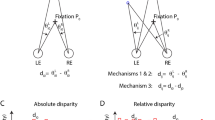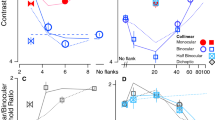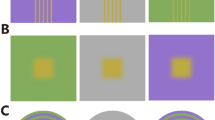Abstract
IT is well known that binocular fusion of slightly disparate images from the two retinae can produce a sensation of depth. The presence of contours was considered necessary for this effect until Julesz1 used computer generated “random dot stereograms” to show that a depth percept can occur in the absence of contours, and indeed stereopsis can create contours. The binocular fusion of colours (red and green), on the other hand, has been a highly controversial subject since the time of Helmholtz and Hering. Hecht2 produced a yellow fusion with red and green wratten filters but Hurvich and Jameson3 have criticized his interpretation of the fusion.
This is a preview of subscription content, access via your institution
Access options
Subscribe to this journal
Receive 51 print issues and online access
$199.00 per year
only $3.90 per issue
Buy this article
- Purchase on Springer Link
- Instant access to full article PDF
Prices may be subject to local taxes which are calculated during checkout
Similar content being viewed by others
References
Julesz, B., Science, 145, 356 (1964).
Hecht, S., Proc. US Nat. Acad. Sci., 14, 237 (1928).
Hurvich, L., and Jameson, D., Science, 144, 199 (1951).
Duke-Elder, S., System of Ophthalmology, 4, 701 (Henry Kimpton, London, 1968).
Author information
Authors and Affiliations
Rights and permissions
About this article
Cite this article
RAMACHANDRAN, V., SRIRAM, S. Stereopsis generated with Julesz Patterns in Spite of Rivalry imposed by Colour Filters. Nature 237, 347–348 (1972). https://doi.org/10.1038/237347a0
Received:
Issue Date:
DOI: https://doi.org/10.1038/237347a0
This article is cited by
-
Influence of Exclusive Binocular Rivalry on Perceived Depth in the ‘Sieve Effect’
Optical Review (2006)
-
A neurophysiological model for anomalous correspondence based on mechanisms of sensory fusion
Documenta Ophthalmologica (1981)
Comments
By submitting a comment you agree to abide by our Terms and Community Guidelines. If you find something abusive or that does not comply with our terms or guidelines please flag it as inappropriate.



